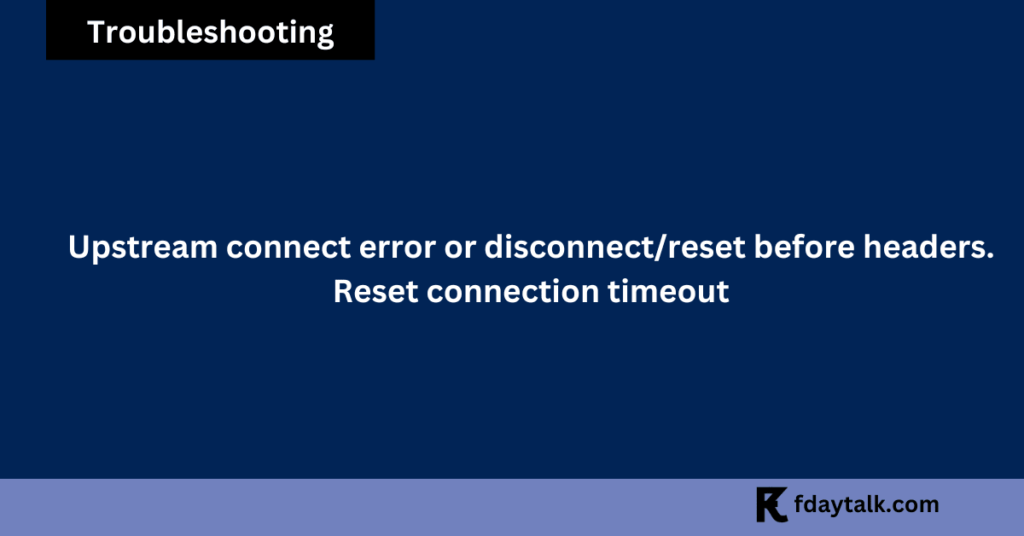When encountering the error message, “upstream connect error or disconnect/reset before headers. reset reason: connection timeout,” it typically points to a disruption in communication between a client and an upstream server. This problem can manifest in various scenarios, such as web application deployment, microservices communication, or when using service meshes like Istio.

Upstream Connect Error
The error generally means that the client’s connection to the upstream service was either closed or reset before the server could send a response. This interruption could result from network issues, misconfigurations, or resource constraints. Let’s break down the common causes.
Common Causes of the Error
1. Network Configuration Issues
- Firewalls or security groups may be blocking necessary ports.
- Network policies might restrict traffic between services or pods in a Kubernetes cluster.
2. Service Configuration Errors
- The upstream service might not be listening on the expected network interface or port.
- Misconfigured service definitions in tools like Kubernetes or Docker Compose.
3. Resource Constraints
- Insufficient CPU or memory resources can lead to service instability.
- High traffic may overwhelm the service, causing it to become unresponsive.
4. Application-Level Problems
- Bugs in the application could cause it to crash or prematurely close connections.
- Improper handling of client requests can result in connection termination before the server responds.
5. Timeout Settings
- Improper timeout configurations for upstream services, proxies, or load balancers can cause these errors.
Steps to Troubleshoot and Resolve the Issue
1. Verify the Health of the Upstream Service
- Check service status: Ensure the upstream service is running and healthy.
- Inspect logs: Review application logs to identify errors or exceptions.
2. Review Network Configurations
- Firewall rules and security groups: Confirm that all required ports are open.
- Network policies: Check Kubernetes or cloud provider network policies to ensure inter-service communication is allowed.
3. Validate Service Definitions
- Ensure that services are listening on the correct ports and interfaces.
- Verify that your Kubernetes manifests or Docker Compose files have accurate service configurations.
4. Monitor Resource Usage
- Check CPU and memory usage to confirm that the upstream service has sufficient resources.
- Consider scaling your services horizontally or vertically if they’re under heavy load.
5. Debug Application Code
- Review application code for potential bugs that could cause instability.
- Implement proper error handling to ensure connections are not prematurely closed.
6. Inspect Timeout Settings
- Adjust timeout configurations for proxies, load balancers, or service meshes to ensure they align with the expected response time of upstream services.
Platform-Specific Considerations
Kubernetes Environments
In Kubernetes, this error can arise due to:
More Tech Guides
- 01How to Fix Windows 11 HYPERVISOR ERROR BSOD on Boot or Resume From Sleep
- 02Windows 11 Installation Stuck or Fails During Upgrade Process (How to Fix)
- 03Windows Upgrade Error 0x8007042B-0x2000D When Updating From 23H2 to 25H2 (How to Fix)
- 04How to Fix Windows 11 Version 25H2 Update Error 0x8007001F
- 05How to Enter Old PC Name in Windows Backup to Restore Files Successfully
- 06How to Fix “Install Driver to Show Hardware” Error During Windows 11 Installation
- 07How to Fix Windows 11 Update Error 0x800f0983 (KB5066835 Failed)
- 08Windows 11 Activation Internet Verification Error: How to Fix It
- Misconfigured service ports: Ensure that the “targetPort” and “port” fields in your service definition match the actual application configuration.
- Network policies: Verify that Kubernetes NetworkPolicies are not unintentionally blocking traffic.
Service Meshes (e.g., Istio)
- Check Istio’s VirtualService and DestinationRule configurations to ensure correct routing.
- Validate the readiness and health of Istio sidecar proxies (Envoy).
Key Takeaways
- The “upstream connect error” often stems from network, service, or resource-related issues.
- Systematic troubleshooting—from verifying service health to reviewing configurations and logs—can help identify the root cause.
- Monitoring and scaling resources appropriately can prevent future occurrences of this issue.